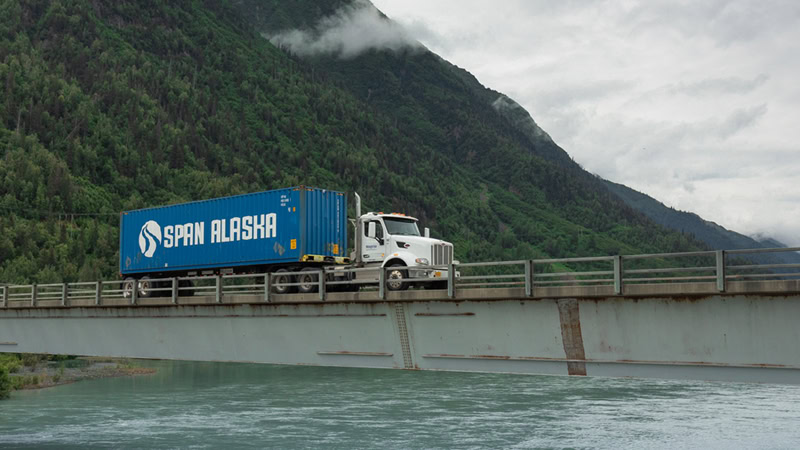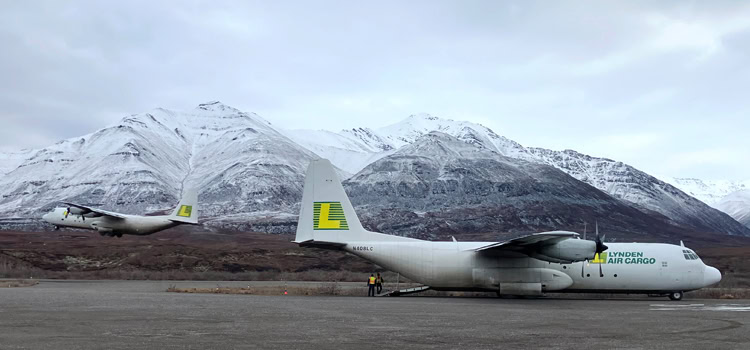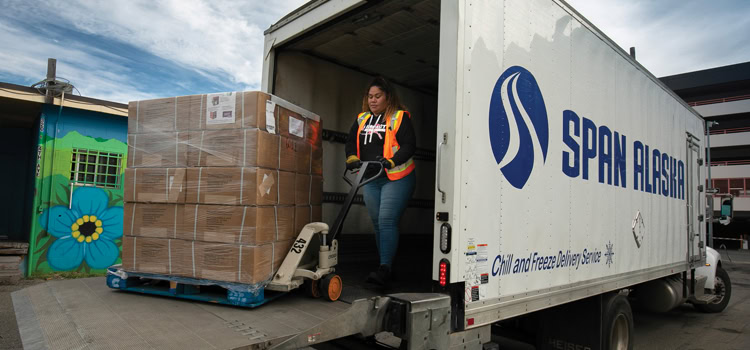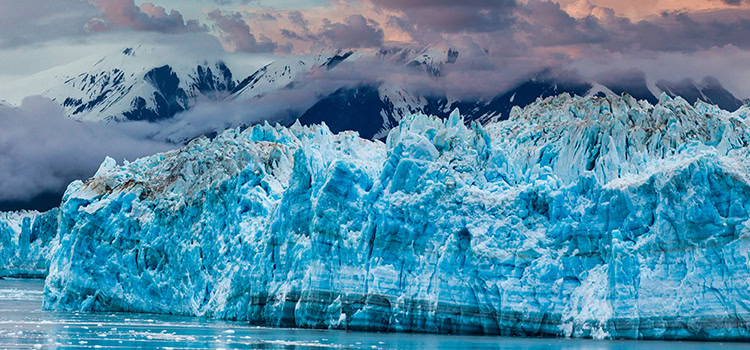Alaska: Extreme Logistics

With its remote but supremely strategic location, the Last Frontier rewards logistics providers that are relentlessly resourceful.
While vacationers can hope to traverse Alaska with little more than an adventurous spirit and creative improvisation, tackling logistics in the Last Frontier requires both resourcefulness and meticulous consideration.
For those charged with overcoming the state’s daunting logistical challenges in order to transport everything from small packages to heavy machinery across what is by far the largest U.S. state—larger than the next three (Texas, California, and Montana) combined—careful planning is a must for freight to make it to its destination. Logistics providers in Alaska mirror the spirit of the state’s residents: They create solutions to problems that would not even occur to many who live in the lower 48.
That requires not only planning but imagination, resourcefulness, and innovation too. The state’s Department of Commerce, Community and Economic Development, for example, is helping to make the state more navigable for logistics providers, businesses, residents, and vacationers alike by enhancing the exchange of information through technology.
Improving Access
“From a broadband perspective, logistics continue to improve,” says Thomas Lochner, director of the Alaska Broadband Office. The office was created in 2022 to oversee the state’s efforts to ensure high-quality internet capabilities for everyday use. The effort also provides vital assistance to those engaged in the art and science of moving goods.
“Tracking of material is critical to any effective logistical effort,” says Lochner. “Having robust broadband allows instant tracking and cataloging of material. Greater broadband opportunity allows for radio frequency identification to passively monitor shipments as they traverse through the system.”
While the state’s roads and highways are constantly improving, and assets such as Ted Stevens Anchorage International Airport continue to grow, Alaska’s geography will always present obstacles on the ground. Hence, the tremendous value of communication through cyberspace.
“Given that more than 70% of Alaska’s communities are only served with small aircraft or seasonal barges, having precise tracking through access to greater broadband will facilitate better management and shipping analysis,” says Lochner. “This creates the opportunity to optimize shipments to the various villages.”
While the logistical challenges of the state are well-known—remote location complicated by treacherous climate and terrain—businesses gravitate to the state for its strategic global trade advantages.
Often referred to as the “gateway to the world,” Alaska connects North America with Asia, making it an essential hub in the world marketplace. In short, its location provides opportunities that are unmatched anywhere else.
Long-Term Commitment and Vision
Helping in no small measure to make the most of Alaska’s place in the world is the Ted Stevens Airport, which for more than a half-century has played an integral role in the growth of Anchorage, the most populous city in the state, and the state itself. The Anchorage metropolitan area contains nearly 40% of the state’s 740,000 population.
In October 2024, the airport announced the arrival of five new cargo carriers, reinforcing its status as a global air cargo hub. Gov. Mike Dunleavy called the addition of the new cargo carriers “a significant milestone in our strategic plan to continue expanding cargo operations.”
They are part of a long-term vision. “As we invest in building state-of-the-art cargo infrastructure, from additional warehousing to improved ramp space, these new operators will benefit from our ongoing commitment to support the needs of modern air freight,” Dunleavy said.
The new carriers include Awesome Cargo Airlines, Central Airlines of China, Belgian carrier ASL Air Cargo, and CMA CGM Air Cargo. Aerologic Air Cargo also has initiated monthly operations servicing routes from Guangzhou and Hong Kong, effectively connecting these major Asian cities with Cincinnati/Northern Kentucky International Airport.
The Ted Stevens Airport, named for the late Alaska senator, logged a nearly 5% year-over-year increase in cargo activity between fiscal years 2023 and 2024, with an additional 2% growth projected for 2025. No wonder the airport labels itself “world-class” and “world-close.”
None of this is to say that state actions and assets alone will overcome the challenges of the Alaska land- and seascape. Vital to the equation are the capabilities and strengths of the state’s innovative and experienced logistics providers.
Tailored Assets

Perhaps more than anywhere else in the world, Alaska presents logistics challenges that require tailored assets from the logistics providers serving the state. Lynden, a family of companies providing transportation and logistics solutions in Alaska—as well as Canada, the Pacific Northwest, Hawaii, and around the world—views those challenges through a very precise lens.
“Ninety percent of the shipments we handle are LTL, so we are in a great position to understand our customers, including many B2C customers as well as a lot of B2B customers,” says Alex McKallor, Lynden’s executive vice president and COO.
“Because we have an intimate knowledge of the freight, combined with our operating experience in marine, air and truck, and special modes like Hovercraft and PistenBullies and others, we can leverage our experience and expertise,” he says. “When you put it all together like that, it makes us truly unique.”
No inhabited part of Alaska, a state also sometimes called the Last Frontier, is too remote for Lynden to reach. “It’s really everywhere there’s people,” says McKallor. “Our solutions almost always involve some kind of intermodal moves.”
The most difficult locales to reach, he says, are in Western Alaska and the Arctic region. “During large parts of the year, marine operations are impossible due to the ice,” he explains, “so planning ahead on projects and community resupply is critical.”
Nailing the Landing
Even though there are navigable waters in Western Alaska and the Arctic in the summer, challenges persist. “A lot of these locations don’t have dock facilities,” McKallor says, adding that because many locations are very small communities, air service often is limited to small aircraft such as 185 Cessnas.
“You have to land on a beach like the Marines with big ramps that drop down or use Hovercraft to navigate shallow rivers and then go right up the beaches to these villages,” he says.
Lynden supports a large national small-package customer, so the company serves all the state’s small rural communities. “Basically we serve every ZIP code to deliver small packages, most often from online ordering,” McKallor says. “In effect, we serve every part of the state, every ZIP code.”
In order to service the wide array of Alaska’s divergent locations, Lynden has a variety of divergent equipment. Its equipment and vehicles represent a distinguishing characteristic of the company that allows Lynden to operate year-round to the most remote places.
“That’s how we’ve evolved as a company over time,” McKallor says. “We started out as a trucking company into Alaska and then customers asked us for help to get to distant places. We had to ask ourselves how we could do that, and we figured it out.”
Recent transportation equipment and vehicles added to the company’s assets include PistenBullies, which are heavy-duty snowcats, and Hercules aircraft.
“As long as there is a coastline or a short runway somewhere—no matter if it’s made of dirt, gravel, or ice—we can go there,” McKallor says. “That has really changed the landscape for us. It’s customer-driven.”
The Right Stuff

Shipping products to the harsh and remote regions of Alaska takes a logistics partner with a pioneering spirit, mission-critical reliability, and a weather-tested network of highway, vessel, barge, and air transportation. Span Alaska fits the bill through its investments in new equipment and new service centers in Anchorage and Fairbanks to ensure reliable service throughout the year.
“Span Alaska’s history dates back five decades,” says Michael Johnson, company president. “In that time, we’ve increased our footprint, built a network of service centers, and expanded our multi-modal service offerings across the state. We move about 400 million pounds annually to, from, and within Alaska.”
Span Alaska built the largest freight service center of its kind in Anchorage in 2019. The service center has 88 dock doors, the capacity to handle high volumes of dry and refrigerated products, and includes a large yard specifically designed for the loading and unloading of oversized freight onto flatbeds.
The company also recently expanded its Chill and Freeze service to provide reliable replenishment of perishable products including fresh and frozen food, beverages, and medical/pharmaceutical supplies.
The planned improvements at the Port of Alaska will help to ensure that goods move efficiently into Southcentral Alaska and beyond. They will also create the infrastructure to support the next generation of larger vessels.
Despite the logistics challenges the state presents, Johnson is confident of Span Alaska’s ability to overcome them.
“Alaska’s size and remoteness can make reliable transportation a challenge for all providers,” he says. “Add the harsh weather and lack of infrastructure, including roads, and the complications increase. We pride ourselves on finding a solution—using a combination of modes and equipment—to deliver to the key population centers and even the most remote bush villages and North Slope communities. Our job is to support our customers’ businesses by making the Alaska supply chain reliable and routine.”
Supporting Just In Time
The shortage of large warehouse facilities and distribution centers in the state means that many retailers and manufacturers employ a just-in-time delivery model, as there isn’t enough space to store products for long periods. As a result, Johnson says, companies that need to move freight in Alaska count on consistent and reliable transportation to keep store shelves stocked and operations running smoothly.
To that end, Span Alaska offers a Destination Direct service. Shipments are loaded into containers at the company’s consolidation center in Auburn, Washington, which is close to the Port of Tacoma and SeaTac airport. These containers travel directly to one of Span Alaska’s six service centers in Alaska, with no stop-offs, devanning, or rehandling. “This provides consistently fast transit times, reduces costly delays and reduces handling that may result in product damage,” Johnson says.
“We also offer a Keep From Freezing service in the winter months,” he adds. “Using insulated containers and customized routing, products that can be damaged by cold temperatures—such as paint—can travel throughout Alaska year-round.”
Taking on Challenges
“Alaska is a big state, but a small town.” While the identity of the author has been lost to time, this sentiment is shared by all those who possess the fortitude, the adventurousness, the skill—and the equipment—to take on the logistics challenges of the Frontier State, also known as the gateway to the world.
Logistics providers charged with conquering the state’s formidable challenges and bringing manufacturers and retailers closer to their customers contribute to the fact that, in Alaska, products and those who need them are close enough, no matter how far away.
Weathering the Storms (and More)

Alaska presents more than its share of topographical and climate challenges for logistics providers. Here are a few:
Water Bodies
The Yukon River, almost 2,000 miles long, is the third longest river in the United States. There are more than 3,000 rivers in Alaska and over three million lakes. The largest, Lake Iliamna, encompasses over 1,000 square miles.
Glaciers
Alaska has an estimated 100,000 glaciers, ranging from tiny cirque glaciers to huge valley glaciers. There are more active glaciers and ice fields in Alaska than in the rest of the inhabited world. The largest glacier is the Malaspina at 850 square miles. Glaciers cover 5% of the state, or 29,000 square miles.
Coastline
Alaska has 6,640 miles of coastline and, including islands, 33,904 miles of shoreline.
Volcanoes
There are more than 70 potentially active volcanoes in Alaska. Several have erupted in recent times. The most violent volcanic eruption of the century took place in 1912 when Novarupta Volcano erupted, creating the Valley of Ten Thousand Smokes, which is now part of Katmai National Park.
Earthquakes
On March 27, 1964, North America’s strongest recorded earthquake, with a moment magnitude of 9.2, rocked central Alaska. Each year Alaska has approximately 5,000 earthquakes, including 1,000 that measure above 3.5 on the Richter scale. Of the 10 strongest earthquakes ever recorded in the world, three have occurred in Alaska.
SOURCE: Alaska.gov, official website of the State of Alaska
